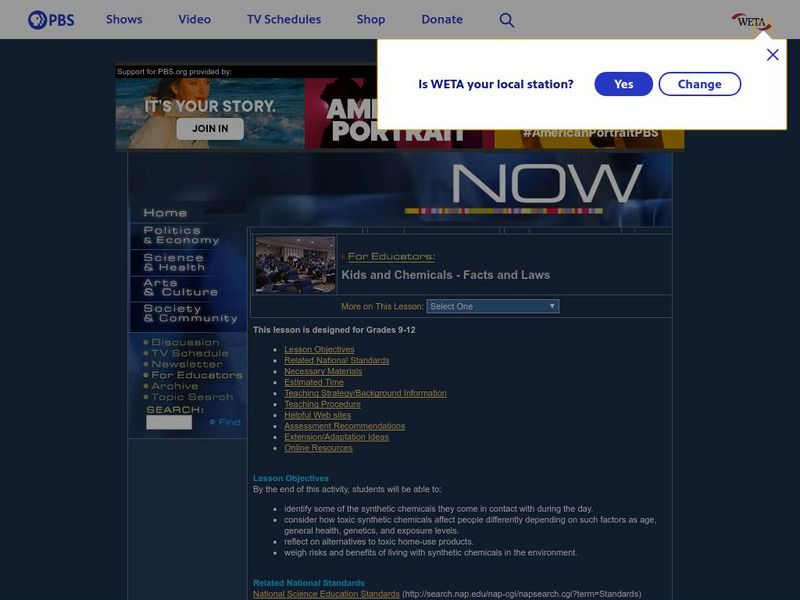Hi, what do you want to do?
Curated OER
Ethical Decision Making in Biology
Students explore a model that illustrates the spread of HIV through an adolescent population. Acting in the role of epidemiologists, students explore the dilemmas of HIV infection presented by a simulation. Students produce a play, skit,...
Curated OER
Using Yeast as an Ultraviolet Light Measurement Tool
Students accurately measure the relationship between radiation dose and either survival or some genetic event such as mutation or recombination. They investigate the damage that was done to the DNA molecule as a result of exposure to...
Curated OER
Making Paper
Students explore how natural earth materials are processed into a human-made product. They simulate a manufacturing process by making paper. Students review the importance of recycling in preserving our natural earth resources.
Curated OER
Power, Pollution, Pros and Cons
Pupils review what they know about non-renewable energy, compare and contrast advantages and drawbacks of each type, such as cost of energy sources, feasibility, air pollution, water pollution, and other risks, and create table listing...
Curated OER
Silent Spring
Students read background information about Rachel Carson found on the listed website links. They analyze and answer questions about her work and how it is linked to science then they research pesticide usage and alternative methods.
Curated OER
Birds of Different Feathers: Species Specialization
Learners identify differences in bird species and explain the concept of species specialization. They attain the knowledge that different birds occupy different habitats.
Students identify characteristics and features of birds that make...
Curated OER
Evaporation of Alcohol and Water
Learners investigate the process that occurs when liquids evaporaate. They test water and alcohol to determine which substance evaporates more quickly and relate the rate to energy changes.
Curated OER
How Big is a Crowd?
Sixth graders compare the relative sizes of the five Great Lakes and their human populations. They describe some of the problems that arise when many people depend on a limited resoure. Students discuss how the Great Lakes and the...
Curated OER
Making Atoms
In this atoms worksheet, students determine an atoms based on its protons, and neutrons. Students determine the electron levels for the oxygen atom. This worksheet has 1 multiple choice, 4 fill in the blank, and 13 short answer questions.
Curated OER
Water and Rice Agriculture
Second graders investigate the agriculture of rice by reading a study guide. In this food making lesson plan, 2nd graders read about the irrigation of rice fields used for harvesting. Students write three sentences about the...
Curated OER
Pheed the World: Edible Phyla
Students discuss the contributions of different organisms to our world. In this biology lesson, students research countries with limited food supply. They create an improvement plan for a fictitious country assigned to them.
Curated OER
Using A Winogradsky Column to Analyze Microbial Communities
Students use easily obtained materials to study ecological succession in a microbiological community. They collect water samples from outdoor sources in plastic bottles to observe and record changes.
National Institutes of Health
Nih Curriculum Supplement Series: Chemicals, the Environment, and You
This comprehensive site from the Office of Science Policy offers a teacher's guide, lesson plans, and student activities that discuss the presence of chemicals in the environment and how they might affect one's body.
Other
Rensselaer Polytechnic Institute: Chemical Equilibrium
This site from the Rensselaer Polytechnic Institute provides an introduction to chemical equilibrium, covering equilibrium expressions, the pH scale, and presenting how to plot log concentration diagrams.
Other
Ithaca College: Project Look Sharp: Chemicals in the Environment
[Free Registration/Login Required] Project Look Sharp offers a unit, complete with lesson plans, PowerPoint presentations, and videos, focused on chemicals in the environment.
Country Studies US
Country Studies: Uzbekistan: Environment
This article from the Library of Congress addresses the sad state of the environment in Uzbekistan caused by chemical, water, and air pollution. Particular emphasis is focused on the Aral Sea.
Other
Pollution Probe: Mercury in the Environment [Pdf]
High levels of mercury exposure can cause birth defects, permanent brain or kidney damage, and/or death. This resource focuses on the impacts of mercury in the environment. Learn how mercury can reap havoc on lakes and other aquatic...
Biotechnology Institute
Biotechnology Institute: Your World: Health Care, Agriculture, Environment [Pdf]
Take a closer look at some of the ways in which biotechnology is applied to help solve medical issues and improve our environment.
PBS
Pbs Learning Media: Environmental Public Health: How Does Your Environment Affect Your Health?
In this self-paced lesson, students learn how environmental factors affect the health of living things, including humans.
Massachusetts Institute of Technology
Mit: Open Course Ware: Chemicals in the Environment: Toxicology and Public Health
A college course featuring instructor's notes and case studies about the relationship between exposure to environmental chemicals and human diseases.
PBS
Pbs Learning Media: Environmental Public Health: Protect Your Health and Environment
Students learn what they can do to protect themselves from health hazards in their environment. They learn about potential hazards, how these can affect their health, and what they can do to minimize their exposure.
US Environmental Protection Agency
Epa: Learn the Issues: Chemicals & Toxics
This site provides real-world issues as well as the scientific research and technology used to support the EPA's mission to protect human health and safeguard the natural environment.
PBS
Now With Bill Moyers: Kids and Chemicals: Facts and Laws
Investigate synthetic chemicals that may be found in one's environment, and consider how toxic synthetic chemicals may affect people differently. Reflect on alternatives to toxic home-use products, and evaluate the risks and benefits.
Rice University
Rice University: Web Adventures: Uncommon Scents
An online game looking at household items contain toxic chemicals and evaluate how they affect our health.






















